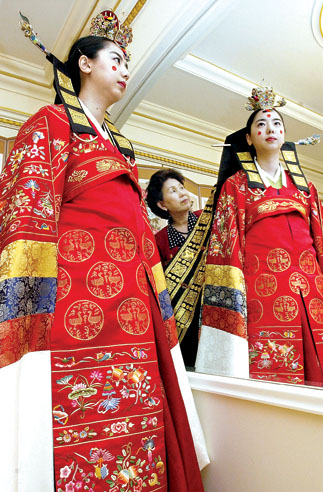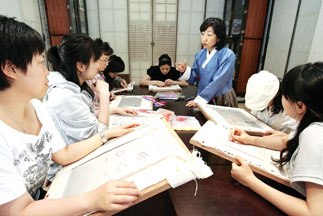Dragons and giraffes dance in colorful, vibrant stitches

Embroidery has long been a key part of traditional Korean culture, using silk threads to make meaningful patterns. From pillow covers to wedding gowns, Korean women crafted embroidered goods with hopes for happiness, health and good luck. [JoongAng Ilbo], By Jeong Chi-ho
On a recent Saturday, in the Bukchon Hanok Village, a cluster of traditional Korean houses in central Seoul, Lee was busy teaching a class of some 20 women from different walks of life, including college students, office workers and housewives. “I have had a male student,” Lee said. “He was actually good at embroidery.” Although her students’ ages and professions may vary, they all have the same passion for silk threads, needles and the tambour.
Kim Young-a, 28, who is preparing to get married, worked hard on some peony blossoms. “I am planning to make an embroidered pillow-cover with small pouches for my in-laws,” Kim said.
Although she is afraid that she won’t be able to finish her work before her wedding day, Kim is proud to be presenting gifts that have been crafted with her own hands.
“It was a tradition for brides to bring works like embroidered thimbles as gifts for their in-laws,” Lee said, scrutinizing the texture of the silk thread used for Kim’s peony blossoms. “It was a kind of ritual for the brides to show their new mother-in-law how clever they are with their hands. Embroidery was an essential part of a noble lady’s education.”
Those Joseon Dynasty days are long gone, yet Lee is glad to see people flocking to her classes.
Lee thinks that embroidery can still play an important role in education, because people can learn how to concentrate and soothe their mind.
“Embroidery is like meditation, because it requires silence and concentration,” Lee said. Seong In-suk, 53, another student of Lee’s, agreed and said that embroidery gives her peace of mind. “Embroidery soothes me,” said Seong, a housewife. “Plus, there is the pleasure I get from making my own accessories.”
Korea is not the only country with a centuries-long tradition of embroidery, yet there are certain characteristics that define the Korean style. Lee said that one of the characteristics of Korean embroidery lies in the simplicity of the materials.
“Western embroidery uses a number of patchworks and beads, but the Korean style just uses silk thread,” Lee said. “Embroidery itself is like the jewel on the cloth.” In order to create different patterns with the simple materials, various techniques were developed.
Lee noted that there are several dozen ways to vary the shape and angle of the stitches. For example, a tree leaf can be represented in different ways depending on whether horizontal, vertical or oblique lines or repeated short stitches are used. Bride-to-be Kim was using a technique called jaryeonsu on her peony petal, making stitches with different lengths and colors to represent rich colors and textures. Flower petals and tree leaves are often made using this technique.
Lee also noted that geometrical patterns are often used in Korean embroidery, mostly to fill up large spaces. One such example is the byeolmunuisu, which uses lines and triangular shapes to create star-shaped patterns.
When Lee needs to create something extremely delicate, such as a human face, she untwists the threads into thinner yarns. Her raw material is only thread, but there are many ways to play with it and she can access a great variety of colors.
Han Yeong-hwa, author of “Korean Traditional Embroidery,” writes that the characteristics of the Korean embroidery developed from the fact that Korean women have used the art in a wide variety of ways for centuries.

A wedding gown based on one made for the royal family of the Joseon Dynasty. It is embroidered with patterns and birds that symbolize hopes for a happy marriage. [JoongAng Ilbo]
In her book Han said that a crane has long been a favorite pattern for embroidery as Koreans believe it to be a symbol of longevity because it is the “bird that lives the longest.” The crane is one of 10 items that Koreans believe symbolize longevity and immortality. The ten, called sipjangsaeng, include the turtle, deers and pine trees and all are frequently used in Korean embroidery.
For a newly wed, it is essential to embroider a pair of wonang ― or Mandarin ducks ― on their pillow cases. These birds are believed to be a symbol of love. Han explained that when one of them dies the other will not try to find another mate. Other patterns for newly weds include fish and lotus flowers, symbols of a happy marriage and fertility. During the Goryeo Dynasty (918 to 1392) it was believed that embroidering two fish playing together would bring a couple lasting conjugal bliss. The lotus bears its flowers and seeds at the same time, which was why it is considered to be a symbol of good luck for child bearing.
Embroidery was also used to display rank at the royal court, as there were fixed patterns for each level of the royal family and officialdom. The dragon and phoenix were for the king, embroidered on his clothes and household goods.
The dragon has long been a symbol of royalty, and the phoenix, or bonghwang in Korean, was a bird associated with peace and affluence. Crown princes were allowed to use the dragon patterns as well, although their’s had fewer toes. Other members of the royal family had embroidered giraffes and other imaginary animals that were believed to symbolize peaceful times. Meanwhile, the highest level of officialdom wore peacock embroidery. The second rank had wild geese and the third a crane.
Another favorite style was to embroider Chinese characters that symbolize good luck. The Chinese characters for happiness, luck, wealth and nobility were the ones used most frequently. Embroidery of letters is a long tradition ― Han noted that Queen Jindeok of the Silla Kingdom embroidered a poem with more than 100 Chinese characters and sent it as a gift to the emperor of the Tang Dynasty.
Korea no longer has a royal family to wear the dragon embroidery yet there are still people who are willing to learn the art, like those attending Lee’s class. There were times when traditional embroidery was given a cold shoulder, especially during the mechanized economic development that followed the Korean War, but nowadays there are more people who want to learn the art.
The tradition of embroidering items from everyday life is still popular. Lee’s student Seong said she has embroidered her cell phone accessories, cosmetic pouches and broaches. “It’s meaningful for me to build a bridge between tradition and the present day using my own hands,” Seong said.

Lee Seoung-hee, in a hanbok (traditional Korean dress) with students at her Saturday embroidery class. By Jeong Chi-ho
Bukchon Cultural Center
Seoul city government offers embroidery as one of a range of classes it offers to those members of the public interested in Korea’s traditional culture.
Location: Bukchon Hanok (Korean traditional housing) Village
Transportation: Anguk Station on No. 3 line, exit No. 3
For more information, call (02) 3707-8270.
Korea Embroidery Museum
Open from 10 a.m. to 4 p.m. on weekdays (closed on weekend and holidays)
This museum is rather petite in size yet it has displays of more than 100 works of fine embroidery on clothes and folding screens.
Location: Nonhyeon-dong, southern Seoul.
Transportation: Best reached from Hakdong Station, No. 7 line, exit No.10.
For more information, call (02) 517-0636.
The Chung Young-yang Embroidery Museum at Sookmyung Women’s University
Open from 10 a.m. to 5 p.m. Closed on holidays and Sundays
This museum boasts a wide range of embroidery including 800 pieces donated by the embroidery artist Chung Young-yang.
Location: Sookmyung Women’s University
Transportation: Sookmyung Women’s University Station on line No. 4, exit No. 9 and 10.
For more information, call (02) 710-9134.
Han Sang-soo Embroidery Museum
Open from 10 a.m. to 6 p.m. Closed on Mondays
This small museum in a traditional Korean house displays works by Han Sang-soo, designated by the government as an embroidery master.
Location: Gahoe-dong, Jongno
Transportation: Anguk Station on No. 3 line, exit No. 2
For more information, call (02) 744-1545.
By Chun Su jin [sujiney@joongang.co.kr]










with the Korea JoongAng Daily
To write comments, please log in to one of the accounts.
Standards Board Policy (0/250자)